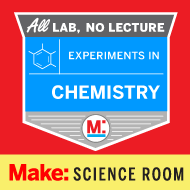This article incorporates, in modified form, material from Illustrated Guide to Home Chemistry Experiments: All Lab, No Lecture.
Chemical kinetics, also called reaction kinetics, is the study of reaction rates in chemical processes. In simple terms, if two reactant molecules are to interact with each other, they must collide with sufficient energy to initiate the reaction. Two molecules that do not collide cannot react, regardless of how high their energies. Conversely, two molecules that do collide, but with insufficient energy, cannot react.
Intuitively, it’s easy to understand that several factors affect reaction rates. Temperature affects reaction rates because molecules at a higher temperature have higher energies, and therefore, any particular collision between reactant molecules is more likely to have the energy needed to initiate the reaction. Concentration affects reaction rates, because the number of reactant molecules is higher in more concentrated solutions, and therefore collisions between reactant molecules are more likely to occur. When one or more of the reactants is a gas, pressure affects reaction rates — gases at higher pressures contain more molecules in a given volume (in effect, their concentration is higher). Finally, when one or more of the reactants is a solid, surface area affects reaction rates, because a larger surface area exposes more of the reactant molecules to collisions with the other reactant or reactants.
A catalyst is a material that affects the rate of a chemical reaction–a process known as catalysis–but is not consumed or changed by the reaction. The presence of a catalyst alters the activation energy needed to initiate and sustain a reaction. Catalysts are most often used to reduce the required activation energy to allow a reaction to proceed quickly at a lower temperature or pressure or concentration than would otherwise be required. Conversely, a negative catalyst (often called a stabilizer or inhibitor) increases the required activation energy for a reaction. Negative catalysts are added to foods and other materials to reduce the rates of the natural chemical reactions within those materials that cause aging, and thereby extend their shelf lives.
In this section, we’ll examine the effects of temperature, concentration, surface area, and catalysis on reaction rates.







Look here for more:…
[…] What web host are you using? Can I get affiliate hyperlink in your host? I want site loaded up as quickly as yours lol[…]…